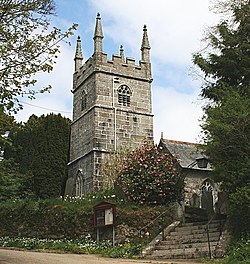Perranarworthal
| Perranarworthal | |
| Cornwall | |
|---|---|
 Perranarworthal parish church | |
| Location | |
| Location: | 50°12’29"N, 5°7’8"W |
| Data | |
| Local Government | |
| Council: | Cornwall |
Perranarworthal is village in Cornwall about four miles northwest of Falmouth and five miles southwest of Truro.
Perran Wharf is the area of the parish beside the River Kennall (a tributary of Restronguet Creek) where there were wharves and a quay. This is currently being developed into Perran Foundry where there will be new homes and working space settled amidst the history of the site. The other settlements in the parish are Perranwell and Perranwell Station.
Perranarworthal parish is bordered on the north by Kea parish, on the east by Restronguet Creek and Mylor parish, on the south by St Gluvias and Stithians parishes and on the west by Gwennap parish. The Parish of Perranarworthal had a population at the 2011 census of 1,496.
William Penaluna described the village in 1838.[1]
Name
The name of the village derives from the Manor of Arworthal which has had a number of spellings in the past including Hareworthal (1187), Arwoethel and Arwythel.
By the 18th century the village is named on maps as Perran Arworthal, meaning 'St Piran’s by the creek', from the dedication of the parish church.
Churches
The 15th century parish church is St Piran's Church, named after Cornwall's famous sain, St Piran. The church was rebuilt to the design of James Piers St Aubyn in 1884. The original granite tower remains from the 15th-century church. Pevsner described the church as "indifferent".[2]
There is also a Methodist church in the village.
Historic foundry
In 1791 the Perran Iron Foundry was built here.[3][4] The foundry was an innovative concern, run by the Fox family of Falmouth and other Quaker business families. It was set up on the site of a tin smelting works. The foundry was later operated in partnership with the Williams family, and in 1858, it was sold to them.
The creek serving the factory silted up and mining in Cornwall declined. The wharf had been used to import timber for the mining industry from Scandinavia. The slump in the mining industry during the 1870s hit Perran Foundry badly and it closed in March 1879 with the loss of 400 jobs, causing great distress in the parish. In April 1879, the 'Royal Cornwall Gazette' reported that a soup kitchen had been open since January: '793 people had attended and 1,240 quarts of soup were distributed'.
The buildings including Manor Mill on the opposite side of the road were later adapted by the Edwards Brothers for the milling and storage of grains and animal foods, and also cloth dyeing; another waterwheel was added. Over the years there have been ambitious plans which have come and gone, but little changed at the foundry site for many years apart from the gradual deterioration of the buildings.[5]
The site has been used for various purposes since but closed in 1986.
Since a planning permission in 2005, the site has been 'under development in recent years' to enable new homes to be built.
About the village
The Perran Foundry, being redeveloped for residences. The site's most iconic building is The Hammer Mill, which has been converted from what was originally the heart of the old foundry, to provide seven unique houses with up to four bedrooms over three floors.
The Norway Inn was known originally as the Norway Hotel and the name derives from the Norwegian vessels which once brought loads of timber to Perran Wharf,[6] largely for use in the mines. The timber would be seasoned by being 'pickled' for several months in shallow tidal ponds. The Norway Inn was built in 1828/1829 at the same time that the main Falmouth to Truro road was rerouted to cross the Carnon River on an embankment just above the village of Devoran.[7] As of December 1, 2011 the Inn, after having had a refurbishment, is once again, after many years, offering accommodation in four of its rooms.
Tullimaar House is an early 19th-century mansion in the parish. It was the home of Nobel Prize-winning novelist Sir William Golding and is still occupied by Golding's son David.
Perranarworthal has a King George V Playing Field.
The village is within the Cornwall and West Devon Mining Landscape world heritage site.
Outside links
| ("Wikimedia Commons" has material about Perranarworthal) |
- Cahill Partnership & Historic Environment Service, Environment and Heritage, Planning, Transportation and Estates, Cornwall County Council Cornwall Industrial Settlements Initiative; Perranarworthal (Truro area) 2005 Perran Foundry Heather & Lay Savills
References
- ↑ An Historical Survey of the County of Cornwall, Etc.: In Two Volumes By W. Penaluna Volume 2, pages 157-158. Google Books - Harvard copy, formerly owned by Davies Gilbert
- ↑ Pevsner, N. (1970) Cornwall; 2nd ed. Penguin Books; p. 139
- ↑ Cornish Mining History: Perran Foundry
- ↑ Cornwall Industrial Settlements Initiative Report: Perranarworthal
- ↑ Barton, D. Bradford (1968). The Cornish Beam Engine (2nd ed.). Truro, Cornwall: D. Bradford Barton. pp. 152–159.
- ↑ Perran Wharf photographs
- ↑ The Village of Devoran
- Mining in the Kennall Valley
- Acton, Bob Exploring Cornwall's tramway trails, Volume 2: The coast-to coast trail: Portreath to Devoran and beyond, Penpol, Landmark Publications (1997) ISBN 1-873443-28-5
- Perran Foundry website www.PerranFoundry.com


